 |
| TMSI homepage www.tmsi.nus.edu.sg |
 |
| The Galaxea [Image from TMSI's webpage, http://www.tmsi.nus.edu.sg/research-facilities-galaxea] |
 |
| TMSI research facility on St. John's Island [Image from TMSI's webpage, http://www.tmsi.nus.edu.sg/research-facilites-kent-ridgest-johns-island] |
 |
| The two main research blocks. [Image from St. John's Island Marine Laboratory on FB] |
Located on an off shore island, the SJI research facility gets easy access to flow-though raw, unfiltered seawater with options for filtered seawater or recirculating filtration. There are two indoor aquaria with tank capacities up to 1000 litres within few walking steps from the research blocks and an outdoor area with large aquaculture tanks of capacity up to 5000 litres. Wet laboratories in the research blocks are also outfitted with seawater tables.
 |
| One of the indoor aquaria [Image from St. John's Island Marine Laboratory on FB] |
 |
| Outdoor area [Image from St. John's Island Marine Laboratory on FB] |
Just a few weeks ago (early Jan 2014), I was sad to hear that the marine research facility will soon be shut down due to high operating costs. If the lack of strong funding continues, operations at the facility will stop by 31 March 2015.
If the closure really happens, what will the future be for marine research in Singapore and in the region without a proper working marine laboratory? How will if affect marine research projects even from the moment the news was announced?
The SJI marine laboratory is important for some researches such as cultivation of giant clams, tests of anti-fouling measures and growth of corals that requires easy access to clean, running seawater from the facility's pump and filtration system. This easy access to seawater and close proximity to diverse marine habitats makes the marine lab at SJI so different and unique from its sister facility at Kent Ridge.
 |
| Giant clam research |
 |
| Inspecting fouling organisms on a navigation buoy. [Image from St. John's Island Marine Laboratory on FB] |
My very first visit to this marine lab, and also to this island, began few years ago when I signed up as a volunteer for the Comprehensive Marine Biodiversity Survey (CMBS). They were conducting sorting sessions in one of the research labs and needed volunteers to help them sort out animals collected from mudflat surveys. I volunteered a whole week of my time helping them sort out marine animals. That was the time when I realised that some animals looked the same but different.
From then on, I visited the SJI marine laboratory whenever my working schedule permits me to help in the sorting sessions, helped in their 10th anniversary open house and participated in a bryozoans and hydroids workshop.
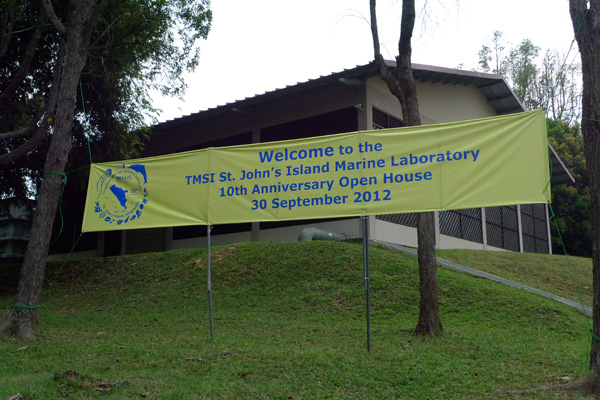 |
| Marine lab 10th anniversary open house. |
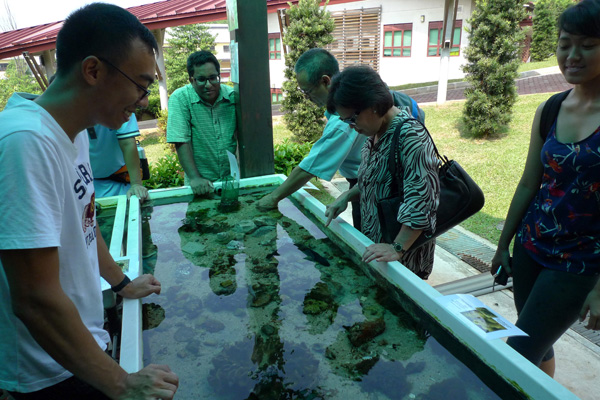 |
| Helping out at the touch pool during the open house. |
 |
| Report on Straits Times, 2 Oct 2012 [PDF version] |
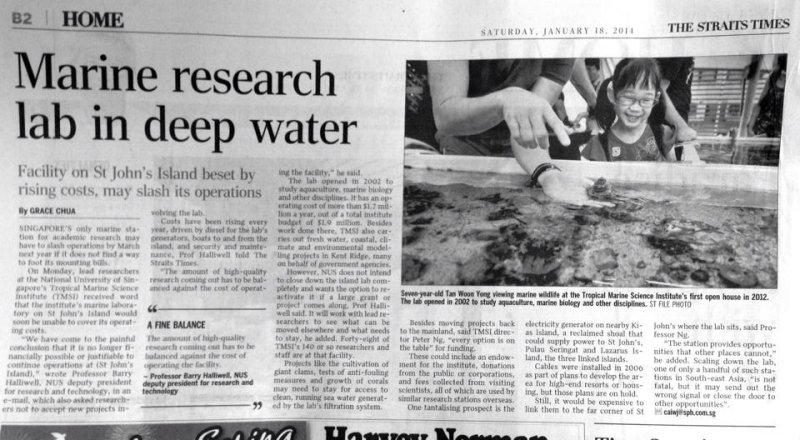 |
| Report on Straits Times, 18 Jan 2014 [Electronic version on STjobs] |
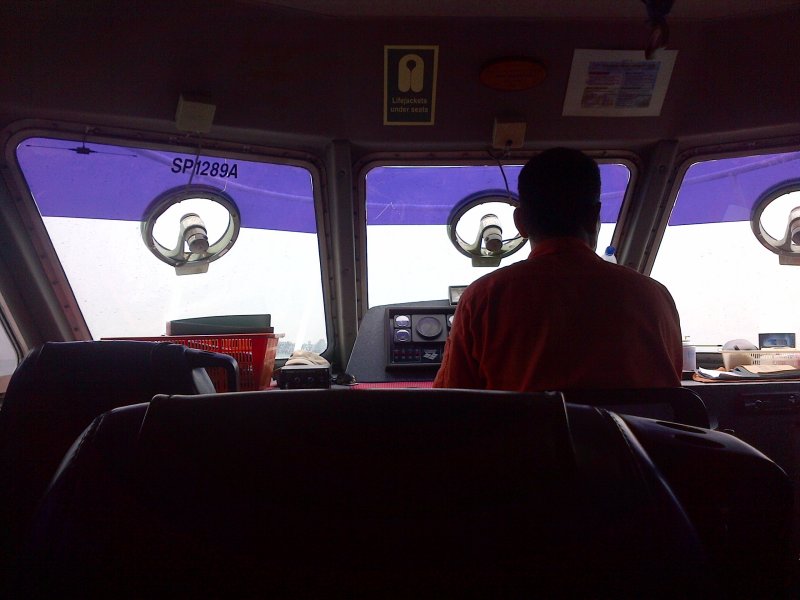 |
| Daily scheduled ferry service to the island for the expedition. |
 |
| Happenings at during the expedition - tagging specimen containers with collection codes. |
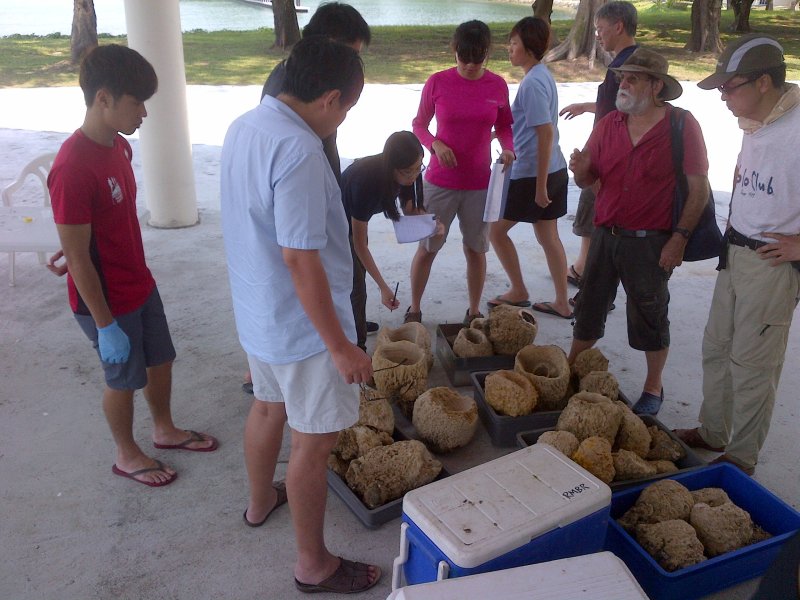 |
| Reviewing the collection of sponges from dredging. |
With the news of the marine lab's closure, a few people that I know off have posted their thoughts in blog posts or on Facebook.
Jocelyne Sze - Things from Tropical Marine Science Institue, St John's Island on Facebook.Mei Lin - Singapore's only marine station
WildSingapore - The value of Singapore's only marine station
Through Jocelyne's Facebook post about her experience at SJI marine lab doing her A Levels H3 Science Research Project with TMSI-SJI, I learnt that the marine lab it not just a place for marine scientists or researchers.
Curious about the new 'A' Level curriculum (2006 onwards) directed me to Ministry of Education's webpage about the 'A' Level. The H3 level subjects allows diverse learning opportunities for in-depth study in the form of advanced content, research paper or through university module. Students taking H3 subject must take the corresponding subject at H2 level. In the list of H3 subjects offered, one of the programme is the NUS-MOE Science Research, which I believe Jocelyne did.
Here is a subject synoposes (PDF document) of the NUS-MOE Science Research.
The objectives of the Science Research are:Good ability 'A' Level students with great interest in marine biology or in research have an opportunity to take this H3 programme as part of their 'A' Level course, developing their capacity to learn independently, with some supervision, through experimentation and research. Prior to this new syllabus implemented in 2006, students are only offered 'S' papers to enrich their content knowledge of a subject higher than the subject content requirement offered at 'A' Level. 'S' paper classes are conducted within the school after curriculum time. With the change in the 'A' Level syllabus, students have a wider range of programme to choose from, including university modules.
Students will be involved in research and are mentored by practising mathematicians, scientists, medical
- To encourage students to undertake research projects in a scientific and technological community
- To promote an early appreciation of the content, methods, culture and ethos of research throughimmersion in the process of scientific inquiry; and
- To enable students to engage actively in research by carrying out substantial parts of the research
independently and responsibly
researchers and engineers from the Faculties of Science, Medicine and Engineering of the National
University of Singapore (NUS) and participating Research Centres/Institutes such as the Institute of
Molecular and Cell Biology, the Tropical Marine Science Institute, the Defence Science & Technology Agency, and the Singapore Botanic Gardens. This programme is accredited and examined by the National University of Singapore.
Mode : Research
Pre-requisites : H2 Biology / H2 Chemistry / H2 Physics / H2 Mathematics / H2 Computing
Assessment : Students undertake the following components:
- Research Plan and Laboratory Work
- Research Paper
- Presentation with Oral Defence
The syllabuses are structured to meet the Ministry's desired outcomes of education in buliding a confident person, self-directed learner, active contributor and a concerned citizen. (PDF version available)
Other than partnering with Ministry of Education in creating a science research programme for 'A' Level students at H3 Level, TMSI-SJI has also conducted education and outreach programme to children and general public. This includes the open house where the research facility is opened to general public to visit and understand the working environment and ongoing projects at the facility. Other than the open house, the SJI marine lab has hosted visiting groups such as the group from Bukit Batok Community Centre and has conducted guided walks at St. John's Island for schools.
 |
| Children from Bukit Batok Community Centre [Image from St. John's Island Marine Laboratory on FB] |
 |
| TMSI's first guide walk at SJI [Photo by Teo Siyang on his blog] |
As part of TMSI's public education programme to create awareness in the marine sciences, the institute conducts organised short visits to our marine research facility at St. John's Island. The two hour programme will introduce visitors to marine science and research at TMSI, with two short talks on highlighting some of our research in the physical sciences and marine biology, and a mini-tour of our facility on St. John's Island.There have also been residential programmes and training workshops in marine science conducted at SJI marine lab, such as sea anemones, bryozoans and hydroids, bivalves and many more.
 |
| Webpage about TMSI's outreach programme [http://www.tmsi.nus.edu.sg/outreach] |
It is really saddening and heartbreaking to learn of the closure of such a great marine station due to high operating cost and lack of funding. Let's hope that things will turn for the better.
 |
| Some of TMSI-SJI staff [Image from St. John's Island Marine Laboratory on FB] |
Useful links:
History of TMSI at St. John's Island (PDF document)
St John's Island Marine Laboratory on Facebook
Scientists, volunteers take part in biggest marine life audit (ST, 24 Oct 2012)
Compliation news about the Southern Expedition on wildsingapore news
No comments:
Post a Comment